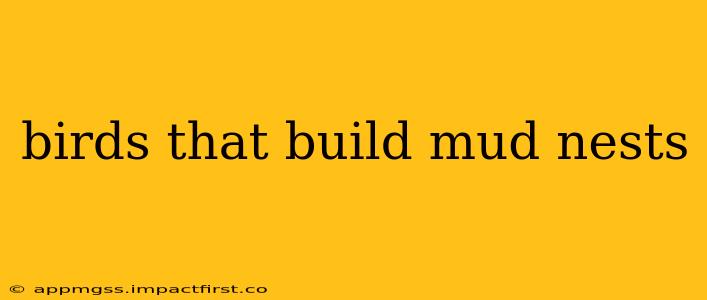Many bird species utilize mud as a key component in their nest construction, showcasing remarkable architectural skills and adaptability. Mud provides a strong, stable base, often combined with other materials like twigs, grass, and feathers for insulation and comfort. This guide explores various bird species known for their mud nests, examining their nesting habits, locations, and the unique characteristics of their constructions.
What birds use mud to build their nests?
A surprising number of bird species incorporate mud into their nest building. Some utilize it as the primary structural element, while others use it as a binding agent to strengthen their nests. Prominent examples include swallows, ovenbirds, and certain species of flycatchers. The specific type of mud used, and the nest's final structure, often vary depending on the species and its environment.
How do birds build mud nests?
The process of mud nest construction involves several key steps. Birds typically gather mud from moist soil, often near water sources. They then carefully mix it with other materials like saliva, which acts as a natural binder. This mixture is then meticulously applied, layer by layer, to create the desired structure. The process can take several days, sometimes even weeks, depending on the complexity of the nest. The resulting nests can be incredibly sturdy and resistant to weather elements.
What are the different types of mud nests?
Mud nests exhibit remarkable diversity in form and function. Some are simple, cup-shaped structures, while others are elaborate, dome-shaped constructions with entrance tunnels. The shape and size of the nest are often influenced by the bird species, its nesting environment, and the available materials. For example, swallows create open-cup nests attached to cliff faces or building structures, while ovenbirds construct enclosed dome-shaped nests that resemble ovens.
What kind of mud do birds use for their nests?
Birds generally use moist, pliable mud for nest construction. The ideal consistency is crucial for ensuring the structural integrity of the nest. Too wet, and the nest might collapse; too dry, and it won't hold its shape. The exact type of mud varies depending on the local environment and the bird's access to water sources.
Why do birds use mud to build nests?
The use of mud in nest construction offers several advantages. Mud provides a strong, stable base for the nest, effectively anchoring it to its chosen location. It's also a readily available material in many environments. Additionally, mud helps to protect the eggs and young from harsh weather conditions and potential predators.
Where do birds that build mud nests live?
The geographical distribution of birds that build mud nests is quite broad. Many species are found in temperate and tropical regions around the world. Their habitat preferences vary, with some nesting in open fields, others preferring wooded areas, and some choosing to build their nests close to human settlements.
Are mud nests waterproof?
While mud itself isn't entirely waterproof, the combination of mud and the bird's saliva creates a surprisingly water-resistant structure. The design of the nest itself also plays a crucial role in providing protection from rain and other weather elements. The roofed nests of ovenbirds, for example, offer excellent protection for their eggs and chicks.
How long does it take to build a mud nest?
The time required to build a mud nest varies widely depending on the species and the complexity of the nest design. Simpler cup-shaped nests might take a few days to construct, while more elaborate dome-shaped nests can require several weeks. The process is often a collaborative effort, with both parents contributing to the construction.
This exploration of mud nest builders provides a glimpse into the remarkable ingenuity and adaptability of birds. Their nest-building techniques are a testament to their evolutionary success and highlight the intricate relationship between these creatures and their environment. Further research into individual species can provide an even deeper understanding of these fascinating architectural marvels.
